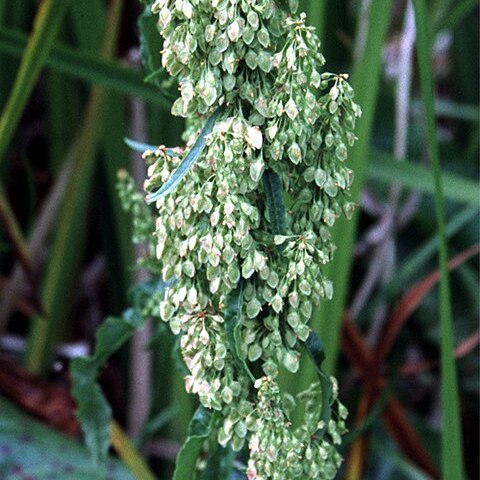Plants perennial, glabrous or very indistinctly papillose, especially on veins of leaf blades abaxially, with fusiform, vertical or oblique rootstock. Stems usually erect, branched from above middle or in distal 2/ 3, 50-100(-140) cm. Leaves: ocrea deciduous or partially persistent at maturity; blade narrowly ovate-triangular, ovate-lanceolate, or oblong-lanceolate, normally 10-35 × 5-12 cm, base weakly to distinctly cordate, truncate, or rounded, margins entire, undulate or indistinctly crisped, apex acute or subacute, rarely obtuse. Inflorescences terminal, occupying distal 2/ 3 of stem, dense to interrupted, narrowly paniculate, often repeatedly branched (branches usually more than 7-8 cm). Pedicels articulated in proximal 1/ 3, filiform, 5-13(-17) mm, normally not more than 2-2.5 times as long as inner tepals, articulation weakly evident, not swollen. Flowers mostly 12-25 in whorls; inner tepals orbiculate, ovate, or broadly ovate-triangular, 5-10(-12) × 5-8(-11) mm, base truncate to weakly cordate, margins entire or subentire to very weakly erose, apex obtuse or subacute; tubercles absent. Achenes reddish brown, 3-4.5(-4.8) × 1.5-2.5 mm. 2n = 120.
More
Stout, taprooted perennial to 2 m; lower lvs 10–30 cm, oblong or linear-oblong, abruptly cordate or subcordate at the base, often crisp-margined; infl of crowded glomerules, at maturity forming a continuous slender panicle to 5 dm; pedicels in fr 5–10 mm, not visibly jointed, but disjointing at a fourth their length; valves cordate-ovate to cordate-triangular, 4–7 mm, about as wide, entire, conspicuously reticulate, without grains; achene 3.5–4.5 mm; 2n=ca 140, 160, 200. Wet soil; N.S. and c. Me. to Nf.; widespread in the w. Cordillera. (R. fenestratus)
A herb that keeps growing from year to year. It has a tap root. It grows 1-2 m high. The stems are erect and stout. They often have a red tinge. The leaves at the base have a long stem. The blades are 10-30 cm long. They are triangle shaped. The have a round base and taper to the point. The leaves up the stem get smaller. The flowers are small and green and in coarse clusters at the top. They become red then brown.
Moist and swampy areas, summer-drying meadows, seacoast to foothills, valley and open montane flats. Wet meadows, bogs, marshes, river banks, shallow water, other wet habitats; at elevations up to 2,500 metres.
More
It is a temperate plant. It grows in moist and swampy areas.


